Hot Research Topics 2014
Hot Topics Home
2015 | 2014 | 2013 | 2012 | 2011
2010 | 2009 | 2008 | 2007 | 2006
Agricultural Research Service Information Staff's Image Gallery - a complimentary source of high quality digital photographs
Animal Heath
 Chickens Open Wide for Gelatin Bead Vaccine
Chickens Open Wide for Gelatin Bead Vaccine
Making sure all newborn chicks are vaccinated right out of the hatchery isn't always easy. Some birds may be missed by standard poultry vaccination methods and, consequently, left with little defense against intestinal diseases. Developed by scientists at the Agricultural Research Service, a new vaccine delivery system to prevent diseases like coccidiosis may be more appetizing to birds than traditional methods.
Coccidiosis, a common and costly poultry disease, is caused by tiny, single-celled parasites. These parasites, which belong to the genus Eimeria, live and multiply in the intestinal tract and cause tissue damage that hinders the bird's ability to digest feed and absorb nutrients. Infected birds shed oocysts-the egglike stage of the parasite-in their feces, and the oocysts transform into infectious forms once in litter, soil, feed, or water. As chickens peck around in the litter, they can ingest the oocysts and become infected. The results are slower weight gain and growth and sometimes death.
Agricultural Research magazine, January 2014 Complete Article
 Pigs Useful in Immune and Obesity Research
Pigs Useful in Immune and Obesity Research
Nutritionist Harry Dawson and microbiologist Gloria Solano-Aguilar, both scientists at the Agricultural Research Service's Beltsville [Maryland] Human Nutrition Research Center (BHNRC), have teamed with scientists from ARS and other organizations to use the pig as an animal model to promote both human and animal health. This research focuses on assessing the effect of nutrition on immune and inflammatory responses.
Dawson helped develop and continues to curate the publicly available Porcine Translational Research Database of genes and proteins for comparison with those prominently studied in rodents and humans. "This database contains functional information on more than 5,800 genes commonly studied in humans, pigs, and mice, including about 2,240 that have been sequenced at BHNRC." The database can be found at tinyurl.com/porcinedata.
Agricultural Research magazine, May 2014 Complete Article
 New Class of Animal Deworming Agent
New Class of Animal Deworming Agent
A team of researchers has demonstrated that when a bacteria-derived protein was fed to worm-infected swine, the infection was nearly completely eliminated.
Intestinal parasitic roundworms are host-species specific and are found in pigs, cats, dogs, humans, and other animals. A roundworm specific to humans, Ascaris lumbricoides, is rarely seen in developed countries. Still, about 1 billion people are infected with this species of worm worldwide, usually via some contact with feces. When A. lumbricoides infects children, nutrient deficiency, respiratory distress, stunted growth, and immune defects occur. In the extreme, infection can cause life-threatening gut blockage. Worms can also migrate into the bile ducts and the permeable membrane that covers the abdominal organs.
Agricultural Research magazine, May 2014 Complete Article
Biocontrol Agents
 Up Close and Personal With Tiny, Beneficial Wasps
Up Close and Personal With Tiny, Beneficial Wasps
Using specialized digital photography methods, Agricultural Research Service scientists and their collaborators are producing high-resolution images of members of the wasp superfamily Platygastroidea. Their goal is to improve the identification and taxonomic description of these tiny insects-including species with potential to biologically control important crop pests.
Of particular interest are 1- to 2-millimeter-long Trissolcus wasps that parasitize stink bug eggs. The larvae of such wasps hatch inside and devour the interior of the bug's eggs, killing them in the process. Some species attack the eggs of the brown marmorated stink bug (BMSB), Halyomorpha halys, an invasive species from Asia that's become established in 39 U.S. states and, in 2010, inflicted $37 million in damage to corn, soybean, grape, and other crops.
Agricultural Research magazine, August 2014 Complete Article
Crop Diversity
 National Inventory Takes Stock of Crops' Wild Relatives
National Inventory Takes Stock of Crops' Wild Relatives
An estimated one of every five plant species worldwide is endangered by habitat loss, climate change, invasive species, and other threats. In the United States alone, roughly 30 percent of native plant species are similarly threatened, and a surprising number may be closely related to crop plants we use every day. Losing these and other crop wild relatives (CWR) could be detrimental to agriculture both domestically and abroad, researchers say. That's because these wild relatives provide critical sources of genetic diversity that can be tapped for an array of economically important traits-such as resistance to emerging pests and diseases, increased yield, and better drought tolerance or adaptability.
Over the past few years, Agricultural Research Service and collaborating scientists have worked to create a first-of-its-kind inventory for U.S. wild and weedy crop relatives that prioritizes the species by their importance to breeding new, improved varieties. In doing this, the researchers looked at how closely related the wild species are to crops-especially those grown for food-which determines the ease or difficulty in transferring desirable traits to their cultivated cousins. Another consideration was their availability in gene banks or protected habitat areas, explains ARS plant geneticist Stephanie Greene.
Agricultural Research magazine, January 2014 Complete Article
Climate Change
 Potatoes Show Promise for Meeting Climate Change Challenges
Potatoes Show Promise for Meeting Climate Change Challenges
New research shows that potatoes-often cultivated as a rainfed crop with little or no irrigation-are still the go-to tuber when times get tough.
Agricultural Research Service agricultural engineer David Fleisher and colleagues wanted to measure how potato plants would respond to elevated atmospheric carbon dioxide (CO2) levels and the increasingly erratic rainfall patterns expected to result from global climate change. So the team conducted two outdoor-chamber studies to evaluate effects of short-term drought cycles at current and elevated CO2 levels. Fleisher and his research partners-plant physiologist Richard Sicher, soil scientist Dennis Timlin, research leader V.R. Reddy, and research associate Jinyoung Barnaby-all work at the ARS Crop Systems and Global Change Laboratory in Beltsville, Maryland.
The studies were conducted using soil-plant-atmosphere research chambers that provided precise control over CO2 levels, air temperature, irrigation, and humidity. The chambers contained sensors that monitored air, soil, and canopy temperatures; relative humidity; and sunlight above and below the canopy.
Agricultural Research magazine, February 2014 Complete Article
 Finding Rice Traits That Tackle Climate-Change Challenges
Finding Rice Traits That Tackle Climate-Change Challenges
People around the world depend on food crops adapted to an array of temperature and precipitation regimes, but those conditions are in flux because of global climate change. So scientists want to identify plant traits that could be used to develop food-crop cultivars that thrive despite-or perhaps because of-shifts in carbon dioxide (CO2) levels, water availability, and air temperature.
As part of this effort, Agricultural Research Service plant physiologists Lewis Ziska, Martha Tomecek, and David Gealy conducted a study of several rice cultivars to determine whether changes of temperature and CO2 levels affected seed yields. They also looked for visible traits that could signal whether a plant cultivar has the genetic potential for adapting successfully to elevated CO2 levels.
Agricultural Research magazine, November 2014 Complete Article
Genomics
 New Tool for Improving Soybeans
New Tool for Improving Soybeans
For all that was gained when soybeans were domesticated thousands of years ago, scientists believe that something was lost: valuable genes left out of today's cultivated varieties that could make them more productive and better able to resist the pests and diseases that are constant threats. Perry Cregan, Qijian Song, and Charles Quigley, who are with the Agricultural Research Service's Soybean Genomics Laboratory in Beltsville, Maryland, have developed a tool to help in the search for regions of the soybean genome where those useful genes could still be found.
The tool is a glass chip with a difficult name: the SoySNP50K iSelect SNP BeadChip. It's about 3 inches long and has an etched surface that holds thousands of DNA markers, which can be deciphered by computers and used by scientists to characterize the genomes of large numbers of soybean plants.
If researchers at ARS and elsewhere scan enough soybean plants, they should be able to discover previously unknown genes associated with important characteristics. The chip will speed up those searches. Genetic information that once took days or weeks to collect can be gathered in about 20 minutes, Quigley says.
Agricultural Research magazine, February 2014 Complete Article
 Making Peach Trees Fit Better on the Field
Making Peach Trees Fit Better on the Field
When you think of the traits a perfect fruit tree should have, you may think of fragrant blossoms or juicy fruit, but the shape of the tree might not occur to you. In fact, tree shape is very important in agriculture. A tree used for agricultural production-whether for fruit, nuts, or lumber-requires extensive land space, mostly because of its large size and spreading growth habit.
Changing the tree's shape, either by pruning or through genetics, will affect how that tree fits among other trees in the field and the number of trees that can be grown in an area. Pruning is expensive and labor intensive. A better option is to genetically alter trees to be more compact so they can be planted closer together to increase productivity.
Agricultural Research magazine, November 2014 Complete Article
 Improving Trout Resistance to a Deadly Disease
Improving Trout Resistance to a Deadly Disease
Each year, the rainbow trout industry suffers significant economic losses due to bacterial cold-water disease, caused by the bacterium Flavobacterium psychrophilum. The disease also affects salmon and other cold-water fish species. It first occurs when fish are small, often leading to rapid death. Larger fish can become chronically infected and consequently have lesions and impaired growth and yield.
At the Agricultural Research Service's National Center for Cool and Cold Water Aquaculture (NCCCWA) in Leetown, West Virginia, scientists have developed a new line of trout that is resistant to bacterial cold-water disease. They've also developed a susceptible line and a control line to use in studies of how breeding changes disease-resistance properties in trout. They have identified regions on several chromosomes that are responsible for disease resistance and have developed a test that detects F. psychrophilum after infection.
Agricultural Research magazine, November 2014 Complete Article
Insect Pests
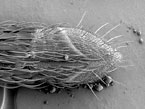 Mosquitoes Reveal a Taste for Repellents
Mosquitoes Reveal a Taste for Repellents
The more scientists learn about mosquitoes' sense of smell and taste, the better they're able to develop ways to protect us against mosquito bites, which can sometimes transmit dangerous pathogens that cause diseases such as malaria, yellow fever, and West Nile virus.
Previous research has shown that DEET, the most common active ingredient in insect repellents, interacts with the mosquito's sense-of-smell (olfactory) receptors, located on its antennae and mouthparts. These receptors pick up carbon dioxide and other odors emitted by humans and animals, leading the mosquito to a host.
Recently, Agricultural Research Service scientists in Beltsville, Maryland, showed that insect repellents also affect the mosquito's sense-of-taste (gustatory) receptors. Entomologist Joseph Dickens and his colleagues in the Invasive Insect Biocontrol and Behavior Laboratory discovered that a taste receptor located on a mosquito mouthpart is sensitive to DEET.
Agricultural Research magazine, August 2014 Complete Article
Plant Biology
 Taming Extreme Environments by Exploring Algae in Space
Taming Extreme Environments by Exploring Algae in Space
It may sound like the opening scene in a low-budget science fiction movie: Scientists send algae into space-some of it mutant-to see if it will grow. But an Agricultural Research Service scientist and an international team of researchers have in fact sent algae into a low Earth orbit to study the effects of space on photosynthesis and plant growth. The research, funded in part by the European Space Agency, is part of an effort to find new ways to produce food and biofuels in extreme environments.
Agricultural Research magazine, May 2014 Complete Article
Plant Pathogens
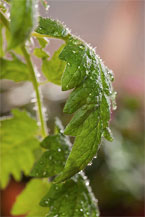 Aspirin-Like Compound Primes Plant Defense Against Pathogens
Aspirin-Like Compound Primes Plant Defense Against Pathogens
Willow trees are well-known sources of salicylic acid, and for thousands of years, humans have extracted the compound from the tree's bark to alleviate minor pain, fever, and inflammation.
Now, salicylic acid may also offer relief to crop plants by priming their defenses against a microbial menace known as "potato purple top phytoplasma." Outbreaks of the cell-wall-less bacterium in the fertile Columbia Basin region of the Pacific Northwest in 2002 and subsequent years inflicted severe yield and quality losses on potato crops. The Agricultural Research Service identified an insect accomplice-the beet leafhopper, which transmits the phytoplasma to plants while feeding.
Carefully timed insecticide applications can deter such feeding. But once infected, a plant cannot be cured. Now, a promising lead has emerged. An ARS-University of Maryland team has found evidence that pretreating tomato plants, a relative of potato, with salicylic acid can prevent phytoplasma infections or at least diminish their severity.
Agricultural Research magazine, February 2014 Complete Article
Nutrition
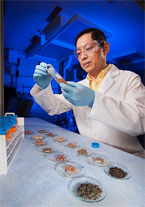 Dietary Products
Dietary Products
Some are Underresearched, Overmarketed - While surfing the Web, you may have seen ads promising "one tip to a flat belly." After clicking on the ad, you jump to a website where official-looking major-news-outlet logos appear. After reading more details about the advertised product, if you clicked "purchase," you took a step closer to achieving the product promoter's goals.
There are several products, such as African mango supplements, that appear at the end of these "one tip" ads. But the real tip is accurate consumer information about the products.
Focusing on Facts - In 2013, ARS nutritionists Seema Bhagwat, David Haytowitz, and Joanne Holden (retired) prepared and launched the USDA-ARS Database for the Flavonoid Content of Selected Foods: Release 3.1. The amount of flavonoids in foods is of interest because of their purported beneficial health effects.
Agricultural Research magazine, March 2014 Complete Article
 Latest Update of USDA's Nutrient Database Released
Latest Update of USDA's Nutrient Database Released
The 2014 update of the Agricultural Research Service's USDA National Nutrient Database for Standard Reference, Release 27, has been launched. The database is managed by scientists with the ARS Nutrient Data Laboratory in Beltsville, Maryland, and is the major authoritative source of food-nutrient profiles in the United States.
The laboratory is part of the Beltsville Human Nutrition Research Center and provides free electronic access to the National Nutrient Database via the World Wide Web. The entire database is also available in a variety of formats that can be downloaded free of charge for use on personal computers and for upload into professional software programs.
Agricultural Research magazine, October 2014 Complete Article
 New Tests Count Total Phenolics in Fruits and Veggies
New Tests Count Total Phenolics in Fruits and Veggies
Agricultural Research Service investigators have a long history of designing and developing reliable analytical methods for measuring nutrients and other compounds in foods. ARS scientists have now devised new analytical methods for detecting and measuring concentrations of phytochemicals called "polyphenols" in plant materials.
The class of health-promoting compounds is found in certain foods and beverages and is also referred to as "phenolics." At the ARS Eastern Regional Research Center (ERRC) in Wyndmoor, Pennsylvania, scientists first reported on the new test and used it on a variety of samples of beverages, such as teas and juices; grains, such as rice and quinoa; and flaxseed.
Agricultural Research magazine, November 2014 Complete Article
Systematics & Collections
 New Reference Provides Uses and Origins of Economically Important Plants
New Reference Provides Uses and Origins of Economically Important Plants
At 1,336 pages, "World Economic Plants: A Standard Reference" is more for professionals and scientists than the casual reader. The book,compiled by an Agricultural Research Service botanist and a University of Texas taxonomist, could also be considered a testament to the diversity of our plant life.
Authors John Wiersema and Blanca Le?n link the list of scientific names with the geographic origins, uses, and relationships of 12,235 plants. They also provide over 50,000 common names for those plants in 27 languages, among them Arabic, Chinese, and Russian. Plants often have different names and uses in different countries, says Wiersema, who is with the ARS National Germplasm Resources Laboratory in Beltsville, Maryland.
The book, published by CRC Press, focuses on plants that are "directly or indirectly important to international [or interstate] commerce ... or have recognized potential for widespread economic usage," according to the text. Plants used for food, fiber, timber, medicines, ornamental purposes, crop breeding, and many other uses are included, along with those having negative impacts, such as invasive weeds and poisonous plants.
Agricultural Research magazine, March 2014 Complete Article
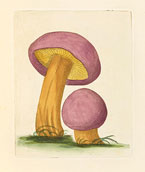 Treasures of the National Agricultural Library
Treasures of the National Agricultural Library
Mushroom hunters-and their more scientific colleagues, the mycologists-are accustomed to seeking their prizes in unusual places. But finding mushroom treasures inside the National Agricultural Library (NAL) is a unique encounter even for them.
For preserved in NAL's Special Collections is a truly irreplaceable specimen: Icones Fungorum circa Halifax Sponte Nascentium, James Bolton's original, hand-drawn manuscript of his highly regarded published work, An History of Fungusses, Growing about Halifax.
The manuscript is 6 volumes with 242 exquisite watercolors of fungi, mostly life-size, with extravagant detail about where Bolton collected the specimen and what he discovered of its biology.
Agricultural Research magazine, August 2014 Complete Article
 Taina Litwak: Insect Illustrator Extraordinaire
Taina Litwak: Insect Illustrator Extraordinaire
Taina Litwak is a scientific illustrator for the Agricultural Research Service's Systematic Entomology Laboratory (SEL) in Washington, D.C. Assigned to a SEL office located at the Smithsonian Institution's National Museum of Natural History, Litwak is ARS's "go-to" illustrator when it comes to detailed drawings and paintings of the latest insect and mite species of scientific interest-some because of the harm they could inflict to crops as invasive pests, and others for their potential to biologically control the pests.
Agricultural Research (AR) magazine recently caught up with Litwak to talk about her work as an ARS scientific illustrator.
Agricultural Research magazine, September 2014 Complete Article
Turr Grass
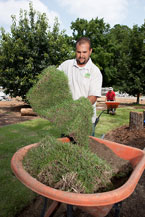 The Greatest Show on Turf
The Greatest Show on Turf
Agricultural research is often thought of in terms of fresh produce, like lettuce, corn, apples, and other nutritious foodstuffs. However, turf is another agricultural commodity deserving of research and improvement.
Agricultural Research Service scientists are working diligently to improve turf grass as a commodity. Along with this research is a new program called "Grass Roots," a 4-year initiative that focuses on turf grass-its uses, management, benefits, and value.
Agricultural Research magazine, October 2014 Complete Article
